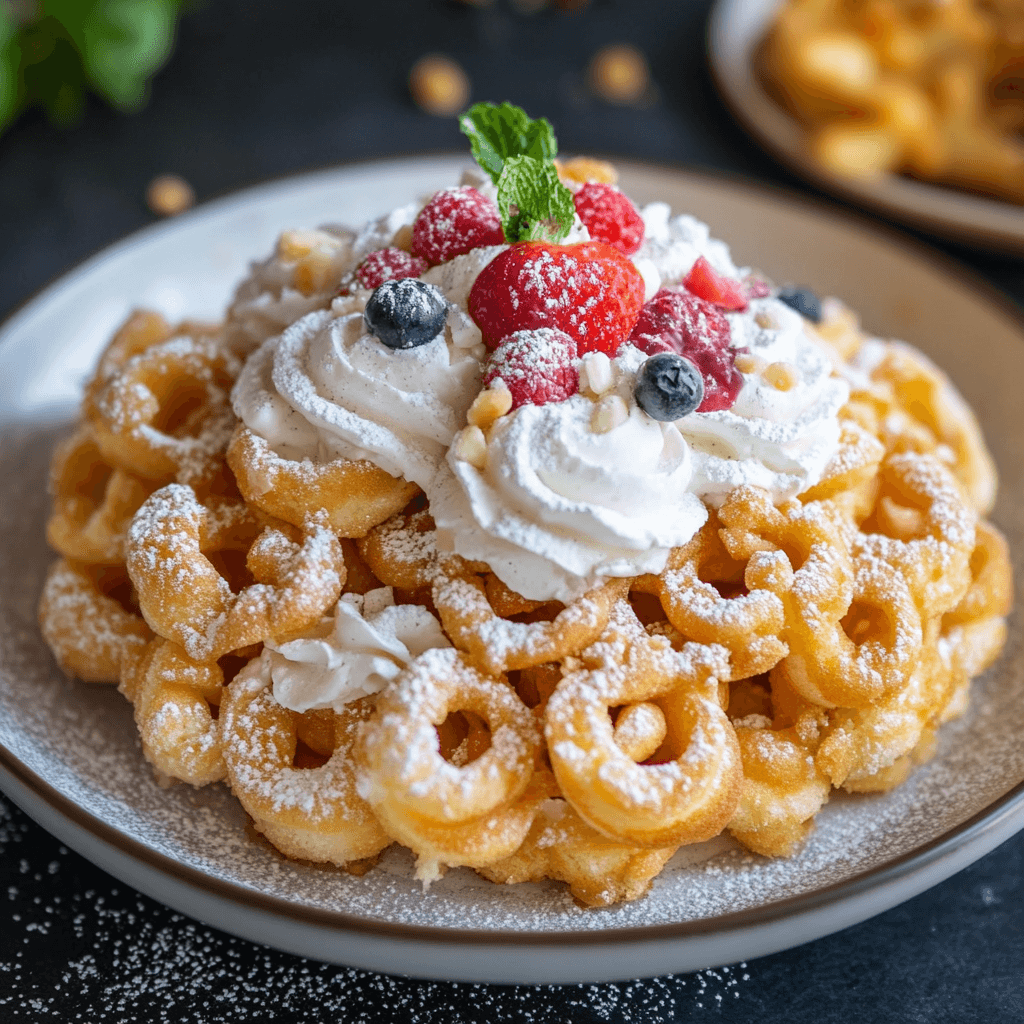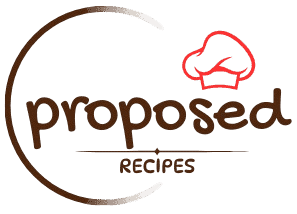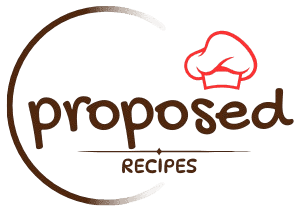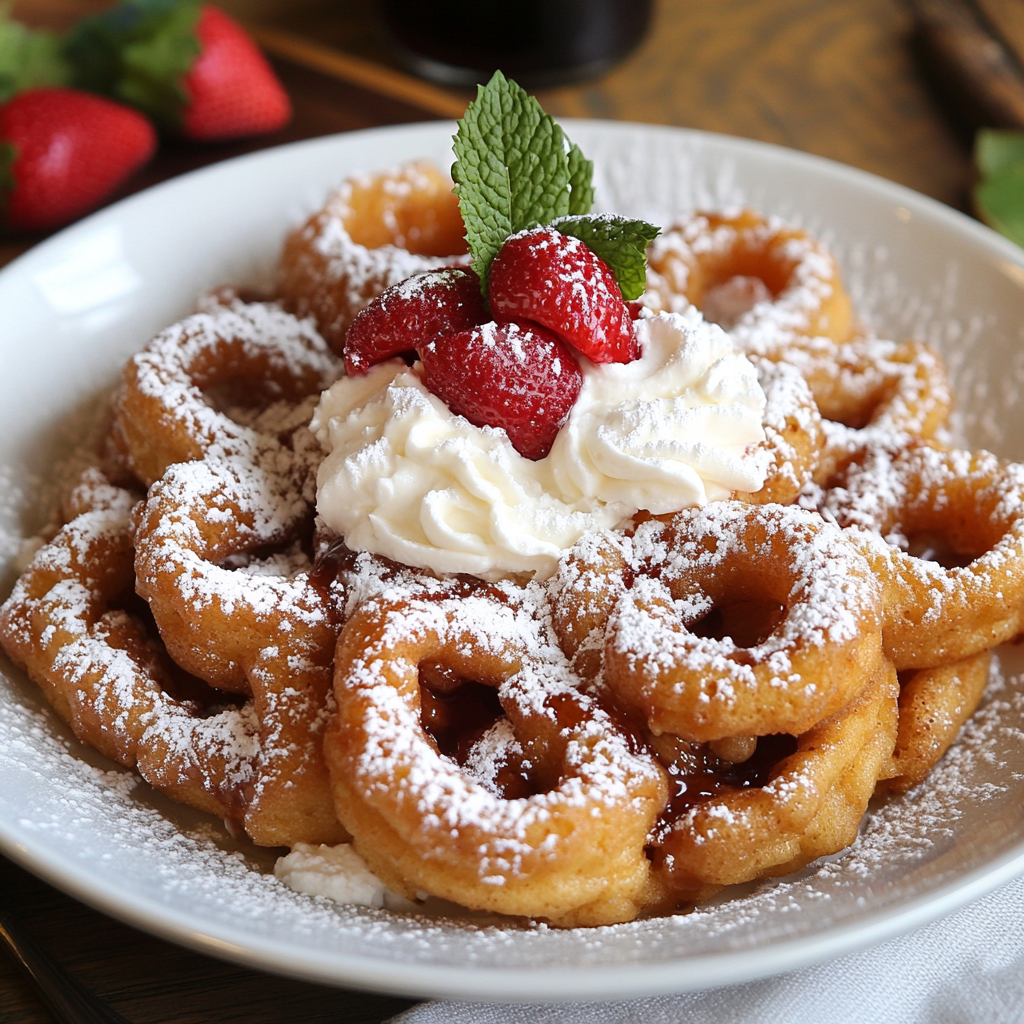Introduction to Funnel Cake
The funnel cake recipe is a beloved fairground classic, cherished for its golden, crispy strands and ability to evoke nostalgic memories of fun-filled days at festivals and carnivals. This delightful dessert is known for its simplicity, yet its crispy texture and sweet toppings make it a crowd favorite across generations. Whether topped with powdered sugar, drizzled with chocolate syrup, or paired with fresh fruit, this homemade funnel cake is a versatile treat that appeals to all tastes. What’s even better is that you don’t need a trip to the fair to enjoy it—you can easily recreate the magic of funnel cakes in the comfort of your kitchen. With a few simple ingredients and the right tools, this funnel cake recipe will help you craft light, crispy, and utterly delicious desserts every time.
History and Origins of Funnel Cake
The history of the funnel cake recipe is as rich as its flavor. Its roots can be traced back to medieval Europe, where variations of fried dough desserts were enjoyed in many cultures. These early recipes often featured simple, affordable ingredients, much like today’s homemade funnel cake. The modern version of the funnel cake owes much of its popularity to the Pennsylvania Dutch settlers in North America, who adapted the recipe and introduced it to local fairs and markets.
Traditionally, funnel cakes were served as a festive treat during holidays or community gatherings, symbolizing indulgence and joy. As the recipe spread, it became a beloved staple at fairs and carnivals across the country. Its affordability and simple preparation allowed it to gain popularity quickly, making the funnel cake recipe a household name. Today, this iconic dessert continues to delight people around the world, not only at festivals but also in food trucks, restaurants, and home kitchens, where anyone can master the art of creating the perfect homemade funnel cake.
Ingredients Needed
Key Ingredients for Funnel Cake
For a perfect funnel cake recipe, you’ll need:
- Flour for structure.
- Sugar for sweetness.
- Milk for a smooth, pourable batter.
- Eggs to bind and add richness.
- Baking Powder for light texture.
- Vanilla Extract for flavor.
Cooking Funnel Cake
The most crucial step in any funnel cake recipe is frying the batter correctly. Use neutral oils like vegetable or canola oil for even cooking and maintain an oil temperature of 375°F (190°C) to achieve the perfect crisp texture.
Choosing the Right Oil for Frying
Neutral oils like vegetable oil or canola oil are ideal for funnel cake due to their high smoke points and neutral flavors.
Temperature Control Tips
Maintain an oil temperature of 375°F (190°C) for even cooking. Use a thermometer to avoid overheating, which can burn the cake, or underheating, which results in soggy texture.
Frying Techniques for Perfect Texture
Pour the batter in a circular motion, overlapping strands for a lacy design. Fry until golden brown on both sides, flipping halfway through. Drain on paper towels to remove excess oil before adding toppings.
Creative Toppings and Variations
Classic Toppings
The most popular funnel cake toppings include:
- Powdered Sugar: A traditional choice that gives a light sweetness.
- Maple Syrup or Honey: Perfect for those who enjoy a richer, sticky texture.
- Whipped Cream: Adds a creamy and airy touch to balance the crispiness.
Gourmet Options
For a more luxurious treat, consider:
- Fresh Fruits: Strawberries, blueberries, or bananas add freshness and color.
- Chocolate Drizzle: Melted dark, milk, or white chocolate enhances the indulgence.
- Nuts: Crushed almonds, pecans, or hazelnuts add crunch and depth.
Savory Funnel Cake Ideas
Turn this sweet treat into a savory snack by adding:
- Cheese and Herbs: A sprinkle of cheddar or Parmesan with fresh parsley.
- Spicy Toppings: Jalapeños and a dash of hot sauce for a kick.
- Bacon and Maple Glaze: A balance of salty and sweet.
Serving and Presentation
Styling Your Funnel Cake for Maximum Appeal
Create eye-catching presentations with vibrant toppings. Use contrasting colors like red strawberries and white whipped cream to make the plate pop. Sprinkle powdered sugar lightly for a snow-dusted effect.
Serving Sizes and Plating Ideas
Serve individual portions or a large, shareable plate for gatherings. Stack mini funnel cakes with layers of cream or fruit for an elegant twist.
Fun Presentation Hacks
- Use a cake stand to elevate the presentation.
- Serve in parchment paper cones for easy handling at events.
- Add edible flowers or themed decorations for special occasions.
Common Mistakes to Avoid

Overmixing Batter
Overmixing is one of the most common mistakes when preparing funnel cake batter. When the batter is overworked, gluten develops excessively, resulting in a dense and chewy texture rather than the desired light and airy feel. To avoid this, mix the wet and dry ingredients just until combined. It’s okay if there are a few small lumps in the batter; they will smooth out during the frying process. Use a gentle folding technique rather than vigorous stirring to preserve the batter’s delicate structure.
Oil Temperature Issues
The temperature of the frying oil is critical to achieving perfectly golden funnel cakes. If the oil is too hot, the batter will cook too quickly on the outside, leaving the inside undercooked. On the other hand, if the oil is too cool, the batter will absorb excess oil, resulting in greasy funnel cakes. To ensure optimal results, use a deep-fry thermometer to maintain the oil at 375°F (190°C). If you notice the oil temperature fluctuating, adjust the heat immediately and wait a few minutes before frying the next batch.
Uneven Cooking or Burning
Uneven cooking often occurs when the batter is poured unevenly or when the fryer is overcrowded. To prevent this, pour the batter in a steady, circular motion, overlapping strands slightly to create the classic funnel cake design. Fry one or two cakes at a time, depending on the size of your fryer, to allow enough space for even cooking. If you notice some parts of the cake browning too quickly, use tongs to adjust the position in the oil gently. Remember to flip the cake halfway through frying for uniform color and texture.
By addressing these common mistakes, you’ll be on your way to mastering the art of making perfect funnel cakes every time!
Funnel Cake Nutrition
Caloric Breakdown of Funnel Cake
A typical funnel cake can range between 300–600 calories, depending on size and toppings. Monitor portion sizes to enjoy without overindulging.
Healthier Alternatives for Ingredients
- Use whole wheat flour instead of all-purpose flour for added fiber.
- Opt for natural sweeteners like honey or agave syrup.
- Fry in oils with lower saturated fat, like avocado oil.
Portion Control Tips
Make smaller, bite-sized funnel cakes for a guilt-free treat. Pair them with fruit for a balanced dessert.
Funnel Cake for Events
Why Funnel Cake is a Crowd Pleaser
Its universal appeal makes funnel cake a hit at any gathering. The warm, crispy treat is easy to customize, making it suitable for all tastes.
Making Large Batches for Gatherings
Prepare the batter ahead of time and fry in batches. Use multiple fryers to speed up the cooking process for large crowds.
Pairing Funnel Cake with Drinks
Complement sweet funnel cakes with hot coffee, milkshakes, or fruity sodas. For savory variations, serve with cold beer or lemonade.
Cultural Variations
Regional Twists in Funnel Cake Recipes
Different regions have their unique takes on funnel cake. For example:
- Jalebi (India): Spiral-shaped, syrup-soaked variation.
- Rosette (Scandinavia): Crisp and delicate, made using special molds.
Unique Flavors Around the World
- Churros (Spain): Similar fried dough with cinnamon sugar coating.
- Beignets (France): Square-shaped and dusted with powdered sugar.
Historical Context of These Variations
Many of these treats were originally festival foods, bringing communities together to celebrate cultural traditions.
Storing and Reheating Tips
Best Practices for Storage
Store leftover funnel cakes in an airtight container at room temperature for up to 2 days. For longer storage, freeze them in a sealed bag.
Reheating Without Losing Texture
Reheat in an oven at 350°F (175°C) for 5–10 minutes to restore crispiness. Avoid microwaving, as it can make them soggy.
Avoiding Sogginess
Always cool the funnel cakes completely before storing them to prevent condensation from ruining their texture.
FAQ Section
Can I Make Funnel Cake Without a Deep Fryer?
Yes, you can make funnel cake without a deep fryer. A heavy-bottomed pot or skillet works perfectly. Ensure you have enough oil to submerge the funnel cake fully, and use a thermometer to maintain the correct temperature.
What’s the Best Substitute for Eggs in the Recipe?
For those avoiding eggs, substitutes like a flaxseed mixture (1 tablespoon flaxseed + 3 tablespoons water) or unsweetened applesauce can work. Both options help bind the batter and maintain its texture.
Can I Bake Funnel Cake Instead of Frying?
While traditionally fried, funnel cake can be baked for a healthier alternative. Pipe the batter onto a parchment-lined baking sheet and bake at 375°F (190°C) until golden brown. The texture may differ slightly from the fried version.
How Do I Prevent the Batter from Being Too Thick or Thin?
Achieving the right consistency is key. The batter should be smooth and flow easily through a funnel or squeeze bottle. If it’s too thick, add a small amount of milk. If it’s too thin, mix in a little more flour.
What is the Ideal Cooking Temperature?
The ideal temperature for frying funnel cake is 375°F (190°C). Use a thermometer to ensure the oil stays consistent, as too hot will burn the cake, and too cool will make it greasy.
Can Funnel Cake Be Made Gluten-Free?
Yes, you can make gluten-free funnel cake by substituting all-purpose flour with a gluten-free flour blend that includes xanthan gum or a similar binder for elasticity.
Is Funnel Cake Made from Pancake Batter?
While pancake batter has similar ingredients, traditional funnel cake batter is slightly thicker and often includes a higher proportion of sugar and eggs. Pancake batter can be used in a pinch, but the texture and flavor will differ.
What Are the Ingredients for Funnel Cakes?
Funnel cake typically includes flour, eggs, milk, sugar, baking powder, and a pinch of salt. Vanilla extract or other flavorings can also be added for extra taste.
How to Make a Homemade Funnel?
If you don’t have a funnel, you can use a clean squeeze bottle, a piping bag, or even cut the corner off a plastic bag to create a homemade funnel for pouring the batter.
What Is the Best Oil for Funnel Cakes?
Neutral oils with high smoke points, such as vegetable oil or canola oil, are ideal for frying funnel cake. These oils ensure even cooking without imparting a strong flavor.
What’s the best way to store leftovers?
Keep leftovers in an airtight container in the fridge for up to 4 days. Reheat in the microwave or oven until hot and bubbly. For food safety tips, refer to USDA guidelines on leftovers .
Enhancing the “Funnel Cake Recipe” Article with Internal Links
To enrich the “Funnel Cake Recipe” article, consider incorporating internal links that align with readers’ potential interests. For example, a section discussing healthier ingredient substitutions can link to “The Ultimate Guide to a Delicious Gluten-Free Pancake Recipe”, providing insights into gluten-free options. Similarly, a discussion on creative presentation ideas could link to “The Best Cinnamon French Toast Recipe for a Perfect Morning” to inspire decorative plating with complementary breakfast items. Finally, for readers curious about frying techniques, a link to “The Ultimate Fried Chicken Breast Recipe for Crispy Perfection” could offer valuable tips on maintaining optimal oil temperature and achieving crisp textures.
These internal links not only enhance the user experience but also improve site navigation and SEO performance.
Conclusion and Final Thoughts
Recap of Key Points
Making funnel cake at home is a delightful and rewarding experience. From preparing the batter to frying the perfect golden spirals, this guide covered everything you need to know. We explored essential ingredients, equipment, and creative topping ideas, along with solutions to common mistakes and tips for storing leftovers. Whether you’re making classic funnel cakes or experimenting with savory variations, the key to success lies in following these simple, tried-and-true methods.
Encouragement to Try Making Funnel Cake
Don’t let the frying process intimidate you—funnel cake is easier to make than it seems! With a little practice and creativity, you can enjoy this fairground favorite from the comfort of your kitchen. Whether you’re hosting a party or treating your family, funnel cake is sure to impress.
Inviting Feedback and Sharing Experiences
We’d love to hear about your funnel cake adventures! Share your tips, topping ideas, and success stories in the comments or on social media. Your feedback helps us improve, and your experiences can inspire others to try making funnel cake too. So grab your ingredients, heat the oil, and start creating your own crispy, delicious masterpieces!





